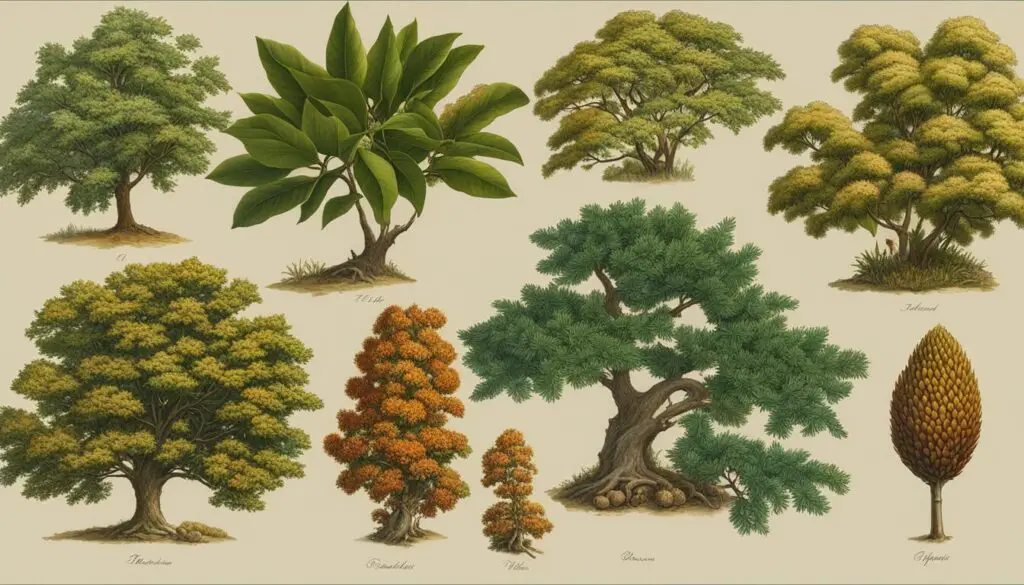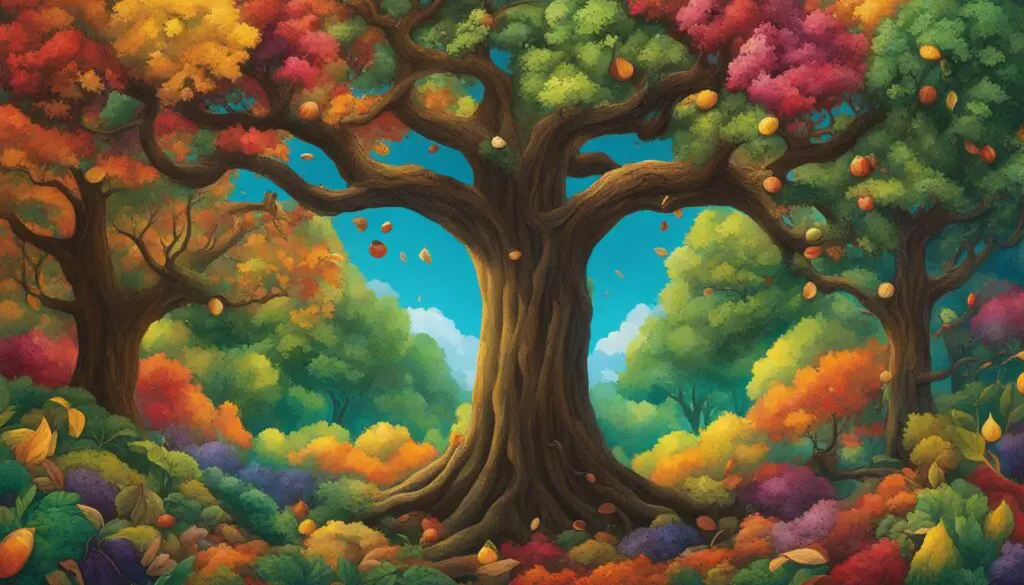Welcome to our article exploring the intriguing world of tree genders and reproduction. Have you ever wondered if trees possess genders like many animals do? The answer may surprise you! In this article, we will delve into the fascinating topic of tree gender, exploring the different types of tree reproductive systems and their significance in tree selection and management. Brace yourself for a captivating journey through the diverse world of tree reproduction!
Key Takeaways:
- Trees have different genders based on their reproductive systems – some have both male and female flowers, while others have separate male and female trees.
- Understanding tree gender is crucial for proper tree selection and management.
- Trees reproduce sexually, with male pollen fertilizing female components to produce viable seeds.
- There are four primary sexual systems in trees: cosexual, monoecious, dioecious, and polygamous.
- Cosexual trees have both male and female parts on the same flower, while monoecious trees have separate male and female parts on the same tree.
How Trees Reproduce
Trees have a fascinating reproductive process, relying on sexual reproduction to produce viable seeds. The process involves male pollen fertilizing female components, leading to the development of new trees. Flowers or cones play a crucial role in this process, as they contain the reproductive organs.
Tree reproduction is diverse, with different species exhibiting various strategies. Some trees have flowers with male parts, female parts, both male and female parts, or no identifiable parts at all. The presence of functional reproductive organs determines the gender of the tree.
In addition to the presence or absence of reproductive organs, tree genders can also change over time or in response to environmental factors. Trees reach sexual maturity and start flowering at different stages of their life. This variability in reproductive characteristics adds to the complexity and diversity of tree sexuality.
Types of Tree Sexual Systems
When it comes to tree reproduction, there are four primary sexual systems that trees exhibit. Understanding these sexual systems is crucial for delving into the fascinating world of tree gender. Let’s explore each type.
-
Cosexual Trees
Cosexual trees, also known as hermaphroditic trees, have flowers or cones that possess both male and female reproductive parts. These trees are self-fertile and can self-pollinate. Examples of cosexual trees include red bud, dogwood, yellow poplar, magnolia, apple, cherry, pear, rhododendron, and American elm.
-
Monoecious Trees
Monoecious trees have separate male and female parts on the same tree. They produce both male and female flowers or cones. Some examples of monoecious trees are fir, birch, hickory, pecan, chestnut, cedar, hazel, beech, walnut, sweetgum, white cedar, and hemlock. These trees rely on wind or insect pollination to transfer pollen between male and female flowers.
-
Dioecious Trees
Dioecious trees have distinct male and female trees. Male trees solely bear male flowers or cones, while female trees exclusively produce female flowers or cones. Examples of dioecious trees include boxelder, persimmon, white ash, ginkgo, holly, red cedar, Osage orange, aspen, and willow. These trees rely on pollinators, such as insects or wind, for cross-pollination between male and female trees.
-
Polygamous Trees
Polygamous trees have a combination of cosexual, male, and female flowers on the same tree or in different combinations on different trees. These trees exhibit varying ratios of male, cosexual, and female flowers, with some individual trees changing gender from year to year. Some examples of polygamous trees include red maple, sugar maple, black ash, locust, mulberry, tupelo, and sumac.

Common Examples of Cosexual Trees
One fascinating aspect of tree reproduction is the presence of cosexual trees, also known as hermaphroditic trees. These trees have both male and female parts on the same flower, allowing them to self-pollinate. Some common examples of cosexual trees include:
- Red Bud
- Dogwood
- Yellow Poplar
- Magnolia
- Apple
- Cherry
- Pear
- Rhododendron
- American Elm
These trees possess the necessary reproductive organs on a single flower, enabling them to produce seeds without the need for pollination from other trees. The ability to self-pollinate gives cosexual trees a unique advantage in certain environments.
“The presence of both male and female parts on the same flower allows cosexual trees to reproduce without relying on other trees for pollination.” – Tree Expert
It’s important to note that while cosexual trees have both male and female parts, not all flowers on a cosexual tree will have both. Some flowers on a cosexual tree may only have male or female parts, while others may have both. The combination of cosexual, male, and female flowers on cosexual trees adds to the diversity of their reproductive strategies.
Benefits of Cosexual Trees
Cosexual trees offer several advantages in terms of reproductive success. Having both male and female parts on the same flower allows these trees to produce viable seeds even in the absence of other trees of the opposite sex. This self-pollination ability increases their chances of successful reproduction, particularly in isolated or sparse environments where the presence of other tree genders may be limited.
In addition, cosexual trees provide a reliable source of pollen for other tree species that rely on cross-pollination. Bees, butterflies, and other pollinators visit cosexual trees to collect pollen, which they then transfer to other trees during their foraging activities. The presence of cosexual trees in an ecosystem enhances the overall pollination network, benefiting a wide range of tree species.
Common Examples of Monoecious Trees
Monoecious trees are a fascinating group of trees that have separate male and female parts on the same tree. They exhibit a unique reproductive system where different flowers or cones on the tree contain either male or female reproductive organs. This arrangement allows for efficient pollination and the production of viable seeds.
Some common examples of monoecious trees include fir, birch, hickory, pecan, chestnut, cedar, hazel, beech, walnut, sweetgum, white cedar, and hemlock. These trees rely on external agents, such as wind or insects, to transfer pollen between the male and female flowers. This ensures cross-pollination and enhances genetic diversity within the tree population.
Understanding the reproductive system of monoecious trees is essential for tree management and conservation. By recognizing the presence of both male and female parts on the same tree, arborists and botanists can better understand the pollination requirements and overall health of these species. It also allows for better planning and coordination when planting monoecious trees in landscaping projects or natural restoration efforts.
Common Examples of Dioecious Trees
Dioecious trees are characterized by having separate male and female trees, with one tree exclusively bearing male flowers and another only producing female flowers. These trees rely on pollinators, such as insects or wind, for cross-pollination between male and female trees. Here are some common examples of dioecious trees:
- Boxelder: Boxelder trees (Acer negundo) are native to North America and have separate male and female trees. Male boxelder trees produce clusters of bright yellow flowers, while female trees bear greenish flowers that develop into winged seeds.
- Persimmon: Persimmon trees (Diospyros spp.) are known for their sweet and juicy fruit. They have distinct male and female trees, with male trees producing small, inconspicuous flowers and female trees bearing larger flowers that give rise to the delicious orange fruit.
- White Ash: White ash trees (Fraxinus americana) are dioecious and native to eastern North America. Male white ash trees produce small clusters of flowers, while female trees produce larger, showier flowers that develop into winged seeds called samaras.
- Ginkgo: Ginkgo biloba trees are ancient and fascinating dioecious trees. Male ginkgo trees produce small cones or catkins, while female trees produce foul-smelling but attractive apricot-like fruits that contain edible nuts.
- Holly: Holly trees (Ilex spp.) are well-known for their spiky evergreen leaves and vibrant red berries. They are dioecious, with male holly trees producing small clusters of flowers and female trees bearing larger flowers that develop into the iconic red berries.
- Red Cedar: Red cedar trees (Juniperus virginiana) are dioecious evergreen trees native to North America. Male red cedar trees produce small, yellowish cones, while female trees produce larger, bluish cones that contain the tree’s seeds.
- Osage Orange: Osage orange trees (Maclura pomifera) are dioecious and known for their distinctive, green, brain-like fruits. Male Osage orange trees produce small flowers, while female trees bear larger flowers that give rise to the unique fruits.
- Aspen: Aspen trees (Populus tremuloides) are fast-growing, deciduous trees commonly found in North America. They are dioecious, with male trees producing clusters of reddish catkins and female trees bearing drooping clusters of greenish catkins.
- Willow: Willow trees (Salix spp.) are dioecious and often found near bodies of water. Male willow trees produce yellow or greenish catkins, while female trees produce smaller, inconspicuous catkins that give rise to fluffy seeds.
These dioecious trees demonstrate the fascinating diversity of tree reproduction and the intricate relationships between male and female trees in ensuring successful pollination and fruit or seed production. Understanding the gender of trees is essential for both natural ecosystems and landscaping, as it can impact the overall health and genetic diversity of tree populations.

Common Examples of Polygamous Trees
Polygamous trees, also known as mixed flowers trees, are fascinating examples of nature’s diversity. These trees have the unique ability to produce a combination of cosexual, male, and female flowers on the same tree or in different combinations on different trees. Let’s explore some common examples of polygamous trees:
- Red Maple (Acer rubrum): Known for its stunning fall foliage, the red maple is a polygamous tree that produces both male and female flowers on separate branches of the same tree.
- Sugar Maple (Acer saccharum): Another iconic tree known for its vibrant autumn colors, the sugar maple is also polygamous, with male and female flowers appearing on the same tree.
- Black Ash (Fraxinus nigra): This polygamous tree features male and female flowers on separate branches, ensuring cross-pollination and successful reproduction.
- Locust (Robinia spp.): Locust trees are polygamous, with some species producing cosexual flowers and others having separate male and female trees. They are valued for their beautiful blossoms and hardy nature.
Additional examples of polygamous trees include mulberry, tupelo, and sumac. These trees showcase the incredible adaptability and diversity of tree reproduction, providing a rich tapestry of floral displays and ensuring the continuation of their species.
Uniqueness in Variety
What makes polygamous trees truly fascinating is their ability to exhibit different combinations of male, cosexual, and female flowers. Some individual trees may even change their gender from year to year. This uniqueness in variety ensures genetic diversity and enhances the chances of successful pollination and seed production.
By embracing and appreciating the diversity of polygamous trees, we gain a deeper understanding of the intricacies of tree reproduction and the remarkable adaptations that have evolved in the natural world.
So, the next time you come across a polygamous tree like the red maple, sugar maple, black ash, locust, or any other member of this diverse group, take a moment to marvel at their complex reproductive systems and the beauty they bring to our surroundings.
Tree Gender and Reproductive Success
Tree gender plays a crucial role in the reproductive success of trees. Male trees produce pollen, which needs to reach female trees for fertilization to occur. This process is known as pollination, and it is essential for fruit production and seed dispersal. Without successful pollination, trees may struggle to reproduce and maintain healthy populations.
Understanding tree gender is particularly important for tree selection and management. Different tree genders can have significant impacts on the overall health and success of tree populations. When planning landscaping or conservation efforts, it is crucial to consider the presence of both male and female trees to ensure successful reproduction.
In some cases, certain tree species require specific tree genders nearby for successful reproduction. This dependency on gender proximity emphasizes the importance of understanding tree gender in maintaining diverse and thriving tree populations. By recognizing the gender of trees and promoting cross-pollination, we can support the long-term sustainability of tree ecosystems.

The Role of Tree Fertilization
Fertilization is a key process in tree reproduction. It occurs when pollen from male trees reaches the female reproductive organs of other trees. This transfer of pollen can happen through various means, including wind, water, or insect pollinators. Once fertilization occurs, trees can produce fruits or seeds, contributing to the next generation of trees.
Impacts on Fruit Production and Seed Dispersal
The successful pollination of trees directly affects fruit production and seed dispersal. Trees rely on animals or natural forces to disperse their seeds, allowing them to colonize new areas and maintain genetic diversity. The availability of both male and female trees increases the chances of successful pollination, leading to abundant fruit production and effective seed dispersal.
Exceptions to Strict Gender Concepts in Trees
In the world of trees, gender is not as black and white as it is in the animal kingdom. Unlike animals, trees do not strictly adhere to the concepts of pure male and pure female. In fact, tree gender can be quite flexible, with different combinations of functional sexual parts in their flowers or cones. This flexibility in tree gender is one of the fascinating aspects of tree sexuality.
While some trees clearly fall into the categories of male or female, many trees exhibit a range of sexual characteristics. Some trees have flowers or cones with both male and female parts, while others may have various combinations of male and female flowers on the same tree or on different trees. This diversity challenges the conventional notion of gender and highlights the uniqueness of tree reproduction.
Understanding the flexibility in tree gender is essential for appreciating the intricate reproductive mechanisms of trees. It reminds us that the world of trees operates on its own terms, with its own set of rules. By recognizing and embracing this diversity, we gain a deeper understanding of the complexity of nature and the wonders of tree sexuality.

The Flexibility of Tree Gender
In the realm of tree sexuality, there is no one-size-fits-all approach. Trees exhibit a remarkable range of gender expressions, defying traditional notions of gender binary. This flexibility allows trees to adapt to changing environmental conditions, ensuring their survival and reproductive success.
- Some trees may change their gender over time, transitioning from a male to a female or vice versa. This phenomenon, known as gender shifting, enables trees to respond to fluctuating ecological pressures and optimize their reproductive strategies.
- Other trees may have different genders on different branches or even within different parts of the same flower. This intra-tree gender variation allows trees to maximize cross-pollination and increase their genetic diversity.
- Some trees may even exhibit transitional genders, possessing both male and female characteristics simultaneously. These intermediate genders, often referred to as “androgyne” or “neuter,” play a crucial role in self-pollination and ensure reproductive success even in the absence of compatible mates.
The flexibility of tree gender challenges our preconceived notions and encourages us to embrace the diversity of life on our planet. By understanding and appreciating the complexity of tree sexuality, we gain a deeper appreciation for the wonders of nature and the interconnectedness of all living things.
Examples of Dioecious Trees in the UK
In the UK, there are several native tree species that exhibit dioecious reproductive systems. These trees have separate male and female individuals, each bearing either male or female flowers. Recognizing the presence of dioecious trees is important for understanding their reproductive patterns and the potential impact on fruit or seed production.
One common example of a dioecious tree in the UK is the ash tree (Fraxinus excelsior). Male ash trees produce small clusters of flowers, known as catkins, while female ash trees produce inconspicuous flowers that eventually give rise to winged seeds. Another dioecious tree found in the UK is the aspen (Populus tremula), which displays tremulous leaves and produces separate male and female catkins.
The willow family (Salix spp.) also includes several dioecious species that are native to the UK. These species, such as the white willow (Salix alba) and the purple willow (Salix purpurea), have male and female catkins on separate trees. Additionally, yew trees (Taxus baccata) are dioecious and display separate male and female cones, with the male cones being smaller and producing pollen that is wind-dispersed.
Key Points:
- Several native tree species in the UK exhibit dioecious reproductive systems.
- Ash trees, aspens, willows, and yews are examples of dioecious trees.
- Dioecious trees have separate male and female individuals, with each bearing either male or female flowers/cones.
- Understanding the presence of dioecious trees is important for understanding their reproductive patterns and fruit/seed production.
Conclusion and Importance of Understanding Tree Gender
Understanding tree gender is essential for making informed decisions in tree selection and management. The gender of trees can have a significant impact on their overall health and reproductive success, making it crucial to consider this aspect.
By recognizing the different genders of trees, we can better understand their reproductive patterns and ensure proper pollination for fruit and seed production. Whether in natural environments or landscaping projects, this knowledge allows us to make choices that support the successful growth and sustainability of tree populations.
Tree gender also plays a key role in the management of tree populations. Knowing the gender distribution within a species can help identify potential challenges and ensure the presence of both male and female trees when necessary for successful reproduction. This understanding allows for more effective tree conservation and management strategies.
So, let us appreciate the fascinating world of tree reproduction by acknowledging the importance of understanding tree gender. By considering the impact of tree gender in tree selection and management, we can create healthier, more vibrant tree populations that contribute to the beauty and vitality of our natural surroundings.
FAQ
Do trees have genders?
Yes, trees have different genders based on their reproductive system.
How do trees reproduce?
Trees reproduce sexually, with male pollen fertilizing female components to produce viable seeds.
What are the different types of tree sexual systems?
Trees exhibit four primary sexual systems: cosexual, monoecious, dioecious, and polygamous.
Can you give examples of cosexual trees?
Examples of cosexual trees include red bud, dogwood, yellow poplar, magnolia, apple, cherry, pear, rhododendron, and American elm.
Which trees are monoecious?
Examples of monoecious trees include fir, birch, hickory, pecan, chestnut, cedar, hazel, beech, walnut, sweetgum, white cedar, and hemlock.
What are some examples of dioecious trees?
Examples of dioecious trees include boxelder, persimmon, white ash, ginkgo, holly, red cedar, Osage orange, aspen, and willow.
Can you provide examples of polygamous trees?
Examples of polygamous trees include red maple, sugar maple, black ash, locust, mulberry, tupelo, and sumac.
How does tree gender impact reproductive success?
Male trees produce pollen, which needs to reach female trees for fertilization to occur. Fruit and seed production depend on successful pollination.
Are tree genders strictly limited to male or female?
Unlike animals, tree gender is not strictly limited to pure male or pure female. Trees can exhibit flexibility in their gender, with different combinations of functional sexual parts in their flowers or cones.
Which native tree species in the UK exhibit dioecious reproductive systems?
Native dioecious tree species in the UK include ash, aspen, various willow species, yew, and others.
Why is it important to understand tree gender?
Understanding tree gender is important for proper tree selection and management, as it can have significant impacts on fruit and seed production, as well as the overall health and success of tree populations.

